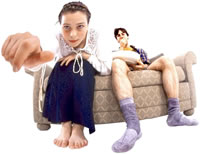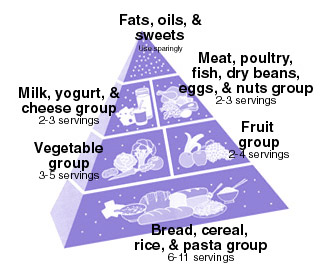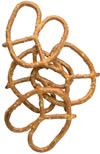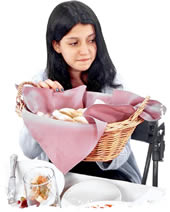

In This Article: |
|
Family Matters |
The Food Guide Pyramid |
So, Where Do I Start? |
What Counts as a Serving? |
Physical Activity |
For a Healthy Diet, Eat Daily |
Get Moving |
Let's Talk About Health |
You Are What You Eat! |
Staying Healthy and Happy |
Family Matters
Are your parents, brothers, or sisters overweight? Do any of them have health problems related to their weight, such as type 2 diabetes? Your family’s gene pool, eating habits, and activities can all play a role in your health and the way you look.
Type 2 diabetes is increasing in adolescents and teenagers who are overweight. Diabetes means that blood glucose (blood sugar) is too high. Diabetes is serious. It can hurt your eyes, kidneys, heart and blood vessels, gums, and teeth.
Even if members of your family have type 2 diabetes or other health problems, it doesn’t mean that you will have the same problems. To lower your chances of developing them, eat healthy foods, get moving, and talk to your family or health care provider if you are concerned about your weight or health.
So, Where Do I Start?
 The
road to better health starts with good eating and physical activity habits.
Being aware of your habits will help you learn where you need to make changes.
The
road to better health starts with good eating and physical activity habits.
Being aware of your habits will help you learn where you need to make changes.
Do you normally watch a lot of TV or play a lot of video games? These activities can be relaxing, but you don’t need to move much to do them. Spending too much time not moving around can make you feel tired and lazy, and lead to poor muscle tone. You can be active every day and still have time to do other things you enjoy, like playing video games!
Physical Activity
Being active means moving more every day. You can choose activities that are fun and do them on your own or with your friends.
Being more active will make you feel better and give you more energy. It can also help you think and concentrate better, which will help you in school or at work. Activity can help you feel less bored and depressed, and help you handle stress.
So don’t wait—start today. Begin slowly and make small changes in your daily routine, like:
What you choose to do is up to you. Just pick something that you like to do and keep it up. Have fun while being active each day to stay healthy and fit. Remember, you don’t have to give up the video games—just make sure that you also fit activity into your day.
Get Moving!

(OK, the last three aren't fun, but your parents will appreciate you doing them!)
You Are What You Eat!
Take a look at your eating habits. What you eat, where you eat, and why you eat are important to your health. As a teen, you need to eat a variety of foods that give you the nutrients your growing body needs. Eating better and being more active can make you feel better and think more clearly.
What do you eat?
 If
you eat a lot of burgers and fries or pizza loaded with toppings—plus an extra
helping of dessert—your diet is probably not balanced.
If
you eat a lot of burgers and fries or pizza loaded with toppings—plus an extra
helping of dessert—your diet is probably not balanced.
There’s nothing wrong with eating these foods—you just need to eat smaller amounts and balance them with other foods.
Where do you usually eat?
If you eat in places such as your room or in front of the TV, you may want to change that habit. Eating while doing other things makes it easy to lose track of how much you’ve already eaten.
By eating meals and snacks at a table, you can pay more attention to what you’re eating so that you don’t overeat.
(If you want to snack while watching TV, take a small amount of food with you—such as a handful of pretzels or a couple of cookies—not the whole bag.)
Why do you eat?
To see if you need to change your eating habits, let’s look at why you eat. For most people, reasons to eat are:
The best reason to eat is because your body tells you that you are hungry. If you are eating when you are not hungry, try doing something else to get food off of your mind. Call a friend, exercise, read, or work on a craft. These activities can help you to cut back on eating when you are feeling bored, upset, or stressed.
To improve your eating habits, try to eat the suggested number of servings from each food group in the Food Guide Pyramid.
The Food Guide Pyramid

Note: A range of servings is given for each group. The smaller number is for people who consume about 1,600 calories a day, such as inactive women. The larger number is for those who eat about 2,800 calories a day, such as teenage boys, active men, and very active women.
Source: U.S. Department of Agriculture/U.S. Department of Health and Human Services
What Counts as a Serving?
Bread, Cereal, Rice, & Pasta Group
1 slice of bread
1 ounce of ready-to-eat cereal
1/2 cup of cooked cereal, rice, or pasta
Vegetable Group
1 cup of raw leafy vegetables
1/2 cup of other vegetables—cooked or chopped raw
3/4 cup of vegetable juice
Fruit Group
1 medium apple, banana, or orange
1/2 cup of chopped, cooked, or canned fruit
3/4 cup of fruit juice
Milk, Yogurt, & Cheese Group
1 cup of milk or yogurt
11/2 ounces of natural cheese
2 ounces of processed cheese (1 ounce is about the size of your thumb)
Meat, Poultry, Fish, Dry Beans, Eggs, & Nuts Group
2-3 ounces of cooked lean meat, poultry, or fish (3 ounces is about the size
of a deck of cards)
1/2 cup of cooked dry beans or 1 egg counts as 1 ounce of lean meat. Two tablespoons
of peanut butter or 1/3 cup of nuts counts as 1 ounce of meat.
For a Healthy Diet, Eat Daily
Breads, Cereals, Rice, and Pasta
(at least 6 servings daily)
Breads: whole-grain, whole-wheat, cracked wheat, multigrain, or oatmeal. (Go
easy on high-fat spreads like butter.)
Cereals: whole-grain, hot and cold.
Rice and pasta: brown rice, whole-wheat or enriched pasta. (Try tomato sauces,
which are lower in calories than cream sauces.)
Fruits
(at least 2 servings daily)
All kinds: fresh, canned, or frozen.
Vegetables
(at least 3 servings daily)
All kinds: fresh, canned, frozen, boiled, steamed, or baked.
Milk, Yogurt, and Cheese
(at least 2 servings daily)
Nonfat or lowfat milk, yogurt, and cheeses. (Foods from this group contain calcium,
which is very important in a growing body.)
Meat, Poultry, Fish, Dry Beans, Eggs, and Nuts
(at least 2 servings daily)
Meat, poultry, and fish: lean, skinless, broiled, roasted, or simmered instead
of breaded and fried. (Or try dry beans and peas, which are lower in fat.)
Let's Talk About Health
 Eat
when you are hungry. Your body will tell you when it’s hungry. Snacking is
OK, but try to go for a variety of nutritious snacks. (See the ideas in the
Snack Attack below.)
Eat
when you are hungry. Your body will tell you when it’s hungry. Snacking is
OK, but try to go for a variety of nutritious snacks. (See the ideas in the
Snack Attack below.) Snack Attack
Staying Healthy and Happy
 Being
a teenager can be tough, and sometimes teens who are healthy try to lose weight
even though they don’t need to. You may feel a lot of pressure to look a certain
way. Acting on this pressure may lead to eating disorders like anorexia nervosa
or bulimia nervosa.
Being
a teenager can be tough, and sometimes teens who are healthy try to lose weight
even though they don’t need to. You may feel a lot of pressure to look a certain
way. Acting on this pressure may lead to eating disorders like anorexia nervosa
or bulimia nervosa.
Anorexia nervosa is a form of self-starvation where a person does not eat enough food to keep healthy and does not maintain a healthy weight.
Bulimia nervosa is when a person eats a lot of food and then vomits or uses
other methods, such as fasting or
overexercising, to avoid gaining weight after overeating.
If you would like to learn more about eating disorders, see the list of resources at the end of this booklet.
If you are concerned about your eating habits or the way you look, it’s important to talk to someone you trust. Try talking to a parent, friend, doctor, teacher, or counselor at your school.
Being happy with who you are and what you look like is important for a healthy body and mind. You don’t have to be an athlete, supermodel, or movie star to like who you are and to stay fit and healthy.
You can take charge of your health by making small changes in your eating and
physical activity habits. These changes will help you feel and look better now
and be healthier for the rest of your life!
This text is not copyrighted.
ToneTeen.com encourage users to duplicate this article and distribute as many copies as desired.
U.S. DEPARTMENT OF HEALTH AND HUMAN SERVICES
National Institutes of Health
NIH Publication No. 01-432